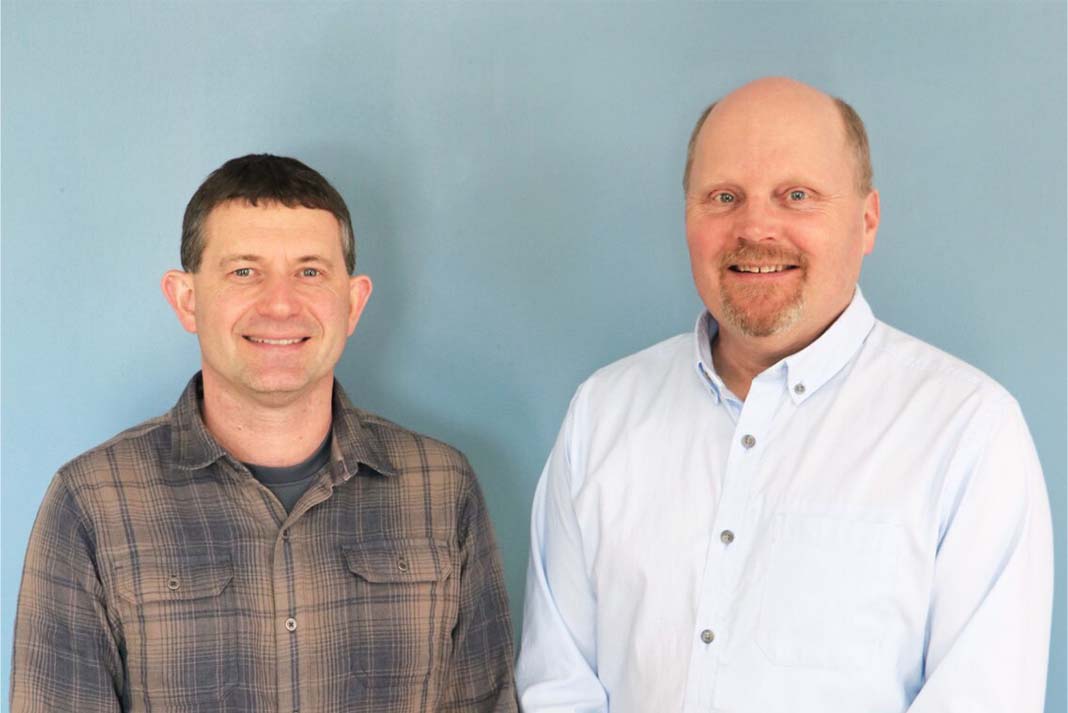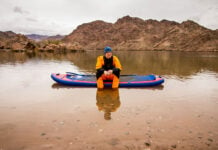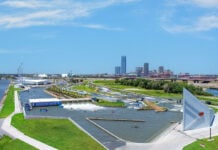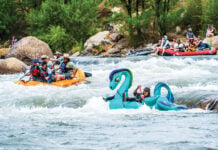In April, Branches LLC, the parent company of paddle makers Bending Branches and Aqua Bound, announced that longtime manager and owner Ed Vater was handing the reins to a homegrown ownership group led by operations manager Jason Eccles.
The company began in a St. Paul, Minnesota garage 40 years ago and, under Vater’s leadership, rose from near bankruptcy to become one of the biggest specialty paddle makers in the world. During that time, Branches expanded into every segment of paddlesports, becoming a global company while retaining the spirit of a family-owned business and manufacturing its products in Osceola, Wisconsin.
Vater had plenty of potential buyers for the business but chose to keep it in the family, selling to three members of the company’s leadership team. Brian Boyea, Cory Novinska and Eccles, who took over as President. Paddling Business spoke to Eccles about his new role in the company, navigating the pandemic and filling some of the biggest shoes in the paddlesports business.
Jeff Moag: Let me start with an anecdote about Ed Vater. A few years ago, I wrote a story that quoted someone with a very optimistic view of SUP sales. Ed promptly sent my editor a note saying the story was “sunshine pumping,” along with figures to back it up. I love that term, but especially his realism at a time when the rest of the industry was, in fact, pumping all the sunshine they possibly could.
Jason Eccles: I chuckle when you use the term sunshine-pumping because we hear that all the time from Ed. He’s going to give you his honest opinion, sometimes whether you ask for it or not. However, it’s always done with integrity and with the other party’s best interest in mind. This trait is one of the essences of his leadership style. He will tell you what you need to hear, even if it may be difficult or unpopular.

JM: Tell me about Ed’s impact, both on the industry writ large and within the company.
JE: Ed is a great relationship-builder and he has this ability, particularly within our industry, to bring key individuals together from different companies that are influential, and he’s done that through the Paddlesports Trade Coalition. He really didn’t want to be the quote-unquote leader in that group, but he ended up being a person that people looked up to. He’s big into paddling, he’s relatable, he’s honest. That setting is like herding cats. There’s a lot going on with many competing agendas and to keep that held together was really a skill.
Thinking about his impact on our company—Branches LLC is the formal name of our company with the two brands, Bending Branches and Aqua Bound—I don’t think it’s a stretch to say that our company may not have survived the early 2000s without him. He brought a consistent approach and a lean manufacturing mindset that allowed Branches to survive a difficult time, and that approach is still part of our identity today. If I were to pick one trait where he has had the greatest impact, it would be his ability and vision to find and grow talent, particularly at the senior leadership level.
JM: You’re part of the team he assembled. How did he influence your career and leadership style?
JE: This is a fun one for me. Ed hired me out of college in 1997, and other than one year between 2002 and 2003, I’ve worked with him my entire professional career. For those familiar with The 5 Levels of Leadership by John C. Maxwell, it is very clear to me that Ed is a Level 5 leader. He has challenged me to be my best self. He helped me develop my strengths and understand my weaknesses. That method of coaching and mentorship has become our consistent method of growing and developing talent. One of our reps, Greg Larson, summarized it perfectly. He said Ed’s trickle down leadership is the best he’s seen.
JM: Tell me about the leadership group taking the baton from Ed. What do Brian Boyea and Cory Novinska each bring to the team?
JE: With Ed’s retirement, we have lost his day-to-day influence. However, there is a combined 62 years of experience at Branches with the remaining five members of our senior leadership team. Those are the other two owners, Brian Boyea and Cory Novinska, along with Andrew Stern, Steve Swanson and myself.
Andrew is our marketing man, and Steve’s our supply chain manager. He’s got the most gray hair, so having his wisdom is great for us. Brian and Cory, the other two owners, have been here seven or eight years apiece. They are relatively young guys in their mid-30s, but they are super-talented and have a lot of energy. I’m 10 or 12 years older than those guys and bring experience to the table. So when I think about our leadership team today, it’s a great balance between wisdom, youthful energy and lean-forward thinking.
JM: Has your 20 years at Branches prepared you to take that baton and run?
JE: The role of President has great responsibility attached to it. The biggest challenge is to maintain and improve the livelihood of all our stakeholders: employees, independent reps and our dealers. Twenty years working next to an amazing mentor has afforded me a great understanding of business, visioning and planning. I’m most excited about the opportunity in three areas: Keeping Branches a great place to work, challenging people and keeping them engaged, and finding and developing talent. Success in these three key areas will allow us to take on any challenges that we will face.
JM: Let’s talk about challenges. How did Branches navigate the difficulties that came with the pandemic?
JE: We do our best to operate with integrity and treat people with respect. We are also diligent about hiring people who share our company’s core values. When we were shut down in the spring of 2020 as a non-essential business, we had to send everyone home. Within a few short weeks, our employees were calling us, wanting to return to work. In most cases, they were making more money staying at home due to pandemic pay, but when our local officials allowed us to return to work in May of 2020, all our employees except for one came back. The one individual who didn’t return decided to retire. Having a workforce dedicated to the ongoing success of our company is the primary reason we’ve performed as we have throughout the Covid pandemic.
“Having a workforce dedicated to the ongoing success of our company is the primary reason we’ve performed as we have throughout the Covid pandemic.”
JM: You’re taking the helm at a time when the macro forces affecting all businesses are hard to predict. We have inflation, interest rates on the rise, a very difficult labor market, and a supply chain in total disarray. I’m especially interested in the last two. Has staffing been a challenge, and if so, how has Branches coped?
JE: While staffing has been a challenge, we’ve successfully added to our team. Our staff count today is more than double what it was pre-Covid. We’ve had to implement a flexible work schedule across a 24-hour period, seven days per week.
I mentioned earlier that reputation was key to this. In 2012, we worked with a strategic planner and put together a number of guiding principles and values. And part of that was a commitment to becoming the employer of choice within a 50-mile radius. When I think about everything that we’ve done through that time period—employee training, leadership development, emotional intelligence training—every year, we’ve done at least one or two things tied specifically to that commitment of over a decade ago. And I think that’s what has allowed us to successfully hire when our competing regional employers have struggled. We don’t pay for referrals, but the majority of our new employees still come from employee referrals.

It hasn’t been without challenges; don’t get me wrong. We’ve had to be creative and flexible for the workforce. It could be a mom who’s got to drive her child to school in the morning and then she’s got to leave at 2:30 to pick him up. So we might get that individual from 8:30 a.m. to 2 p.m., and then we might have a stay-at-home dad who is only available from 4 p.m. to 9 p.m. to work an evening shift. We’re just finding ways of being creative and working within people’s available schedules.
JM: Flexible schedules are the new buzzword in office work, but a production facility is a whole different ballgame. How do you make that work in a factory setting?
JE: It’s extremely difficult. And it has required the cooperation and ability of many individuals who do not have a formal leadership role. People who have been working with us for a long time understand the need and they can help bring somebody new up to speed without a formal manager or a supervisor when we don’t have that level of resource available. And when you bring in good people who are responsible and talented, you don’t need that same level of supervision or support.
JM: How have you navigated the supply chain crisis? What have you learned or adjusted in the past couple of years, and more importantly, as you take the reins—how does that shape your future plans?
JE: Just as all other companies, we have struggled with the procurement of raw materials. We’ve learned that most raw material issues start with a labor shortage somewhere in the supply chain. We’ve taken two key actions which have allowed us to take advantage of new business opportunities.
First, we’ve leaned hard on existing vendors to make good on their promises and develop new vendor partners. And second, although it’s not a good long-term strategy, we’ve had to take some matters into our own hands. For example, last summer, our foam plug supplier was unable to get us foam plugs. Although relatively inexpensive, these are critical components in a kayak paddle as they keep a paddle from sinking. Our engineers developed custom tooling and implemented a process to make our own foam plugs until our vendor could reinstate their supply. Going forward, we will have to plan much further in advance to ensure a smooth flow of incoming materials from our vendors.
JM: Employee-owned companies are becoming less common in this age of consolidation and hungry venture capital. How important was “keeping it in the family” to the new ownership team, and to Ed?
JE: Ed understands the heartbeat of our industry and what’s required to operate a successful business within it. We’ve seen venture capital destroy great companies and numerous paddlesport brands. If you really know and understand venture capital, what happens is that they hook up a pipeline to the company, and that pipeline pumps money. For the first couple of years, the money might flow in both directions, but eventually a check valve gets installed and the money only flows one way.
People are successful in this industry because of our passion for paddling and the outdoors. We don’t believe the profit and ROI goal of venture capital correlates with long-term success in our industry. For this reason, Ed was simply unwilling to consider a venture capital sale. Because of his care and love for our company, its employees and the economic impact Branches LLC has in our local community, an internal transition of ownership was the only realistic option.
“People are successful in this industry because of our passion for paddling and the outdoors.”
I think all along Ed knew that he had a really strong senior leadership team, and that we were ready to take over the ownership whether we knew it or not. But when Ed told us that he was going to retire and that he was offering the company to us to purchase, nobody was ready for that. I can tell you for sure that it was not in my 10- to 15-year life plan.
It took some time to do a little soul-searching and get buy-in from my wife and my family, but it really came down to, ‘If we don’t do this, who will?’ I’ve been here for nearly 20 years. I put a lot of time and energy into this company to help build it to where it is today, and I just couldn’t see that going to somebody else.








